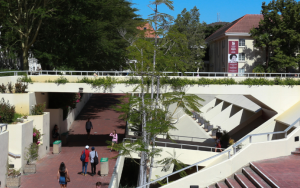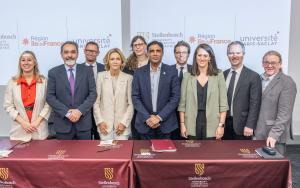
Prof Regan Solomons from the Department of Paediatrics and Child Health delivering his inaugural lecture.
Prof Regan Solomons helps save lives of children with tuberculous meningitis
- Prof Regan Solomons from the Department of Paediatrics and Child Health delivered his inaugural lecture on Tuesday 7 October 2025
- His research focuses on reducing preventable deaths from tuberculous meningitis (TBM) in children
- He helps to find practical and child-specific solutions to TBM in children
Prof Regan Solomons from the Department of Paediatrics and Child Health at Tygerberg Hospital and the Faculty of Medicine and Health Sciences at Stellenbosch University (SU) delivered his inaugural lecture on Tuesday 7 October 2025. The title of his lecture was “Understanding childhood tuberculous meningitis through a patchwork of experiences — searching for Neverland or Sugar Man?”
Solomons spoke to the Corporate Communication and Marketing Division about his role in reducing preventable deaths from tuberculous meningitis (TBM) in children and ensuring that these children have the best possible chance at life.
Tell us more about your research and why you became interested in this specific field.
My research centres on TBM, the most severe form of tuberculosis in children. A high number of cases (40-50 per year) are seen at Tygerberg Hospital, where I trained and work. Therefore, I was confronted with the tragic impact of this disease on children and families – including the high mortality rate and the lasting neurological disability in survivors – very early in my career. That exposure became a natural entry point into research, because I wanted to find better ways of diagnosing and treating TBM, especially in resource-constrained areas.
My clinical and research reasoning around childhood TBM was hugely influenced by two people I consider mentors — Profs Johan Schoeman and Ronald van Toorn. I was fortunate to receive the National Research Foundation-Desmond Tutu–Vrije Universiteit Amsterdam-SU doctoral scholarship, which allowed me to pursue a PhD on improving early diagnosis of childhood TBM.
Since then, my work has focused on every stage of the disease: from refining case definitions and exploring cerebrospinal fluid and blood biomarkers (molecules in the blood that show whether the body is working normally or if there might be a disease or health problem), to metabolomics (the study of the structure, function, and amount of all the small molecules, called metabolites, that cells or organisms produce and use) and novel diagnostic tools.
Together with collaborators, we have registered patents for biomarker-based approaches and contributed to global guidelines, including the World Health Organization’s recommendation of the shorter ‘Cape Town regimen’ (groundbreaking shortened, all-oral TB treatment regimens developed through research in Cape Town) for drug-susceptible TBM in children.
All my work is rooted in the children and families I serve. The aim is not only to advance scientific knowledge, but also to reduce death and disability, and to ensure that children affected by TBM have the best possible chance at life.
How would you describe the relevance of your work?
My research on childhood TBM is highly relevant because it focuses on one of the most severe, neglected, and devastating forms of TB. TBM continues to cause unacceptably high death rates and long-term disability in children, particularly in high-burden and resource-limited contexts.
I have witnessed the tragic consequences of late diagnosis first-hand at Tygerberg Hospital, where children often present with advanced disease and irreversible brain injury. This motivated me to focus on practical solutions to improve outcomes.
The ultimate relevance of this work lies in changing the trajectory of affected children’s lives: reducing preventable deaths, minimising lifelong disability, and strengthening health systems. At the same time, it highlights solutions from high-burden African contexts that can be implemented worldwide.
What are the main challenges in managing and treating childhood tuberculous meningitis?
Childhood TBM is difficult to manage because early diagnosis and treatment are often delayed. The disease begins with vague, non-specific symptoms such as fever, irritability or lethargy, which mimic other common childhood infections, and rapidly progresses to severe neurological illness.
Conventional microbiological tests on cerebrospinal fluid are insensitive i.e. they often fail to detect problems, and advanced molecular diagnostics or neuroimaging (techniques that produce images of the brain’s structure and activity) are not always available in high-burden areas. By the time TBM is recognised, many children already have complications such as hydrocephalus (the buildup of fluid in cavities called ventricles deep within the brain), strokes or cranial nerve palsies (when one of the 12 pairs of nerves that emerge from the brain loses function, affecting movement, sensation, or other activities in the head and neck), making treatment more complex and outcomes worse.
Treatment is also challenging. Not all standard anti-TB drugs penetrate the brain well at routine doses, and there is limited child-specific evidence to guide optimal regimens, especially in drug-resistant disease. Even with prolonged therapy and adjunctive corticosteroids (powerful anti-inflammatory medicine added to the main treatment), mortality remains high, and many survivors are left with lifelong neurological complications, such as epilepsy, developmental delay, cognitive impairment and stroke.
Managing these complications requires multidisciplinary care, rehabilitation and long-term follow-up — services that are often limited in resource-constrained areas. Together, these barriers contribute to the persistently poor outcomes of childhood TBM, despite advances in TB control more broadly.
From your perspective, are current efforts sufficient to address childhood TBM?
No. While global TB programmes have focused heavily on prevention and pulmonary disease (any condition affecting the lungs and respiratory system), TBM in children remains relatively neglected despite being the most devastating form of TB.
Diagnostic tools for children are still too insensitive; child-friendly drug formulations with proven central nervous system penetration are limited; and most treatment regimens are extrapolated from adult studies. There is limited data on host-directed therapies beyond corticosteroids and the lack of systematic screening for neurological complications means many survivors are left without rehabilitation or support.
More targeted investment is needed to improve outcomes. This includes research on rapid and reliable diagnostics, optimised drug regimens for children and integrated care pathways. Strengthening health systems to enable earlier recognition, wider access to advanced care, and long-term support for survivors is also critical. Until these areas are addressed, children with TBM will continue to face high death rates and lifelong disability.
Looking ahead, how can current research improve outcomes for vulnerable children?
It can drive earlier diagnosis, more effective treatments, and better long-term care. Advances in molecular tests, biomarkers, and neuroimaging may enable recognition of TBM before severe brain injury develops, while clinical trials of higher-dose rifampicin, novel drugs, and host-directed therapies offer hope for regimens tailored to children rather than extrapolated from adults.
At the same time, implementation research can strengthen health systems by linking TB programmes with multidisciplinary services, ensuring that survivors receive the developmental monitoring and support they need.
By focusing on child-specific solutions, research can help reduce deaths and disabilities, giving children affected by TBM a fairer chance at survival and a better quality of life.
The higher education environment can be challenging. What keeps you motivated when things get tough?
I try to separate work and family time, as spending quality time with my wife and children always puts things into perspective and helps to recharge my batteries. Having the health and wellbeing of children and their caregivers at the centre of my decision-making is humbling and a good motivation to keep on working and advocating in this space.
Tell us something exciting about yourself that people would not expect.
I am an amateur genealogist, which originated from the need to explain to my children who their ancestors were. At best this is a difficult project, given the complex history of the Cape and South Africa. I also love building Lego with my kids.
How do you spend your free time?
I’m a homebody who loves spending time in the garden and slow cooking when I have time. Vacations are for exploring new places and road-tripping with my family.



